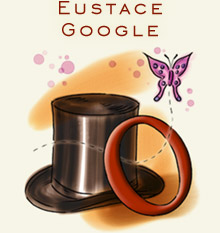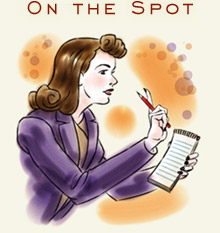Emdashes—Modern Times Between the Lines
The Basics:
About Emdashes | Email us
Ask the Librarians
Best of Emdashes: Hit Parade
A Web Comic: The Wavy Rule
Features & Columns:
Headline Shooter
On the Spot
Looked Into
Sempé Fi: Cover Art
"The Patented Trump Palaver": Time to Reread Singer!
Filed under: Looked Into Tagged: Alex Pareene, Donald Trump, Marc Singer, New Yorker, Profiles, Salon

Emily Gordon writes:
Anyone who’s surprised by reports about Donald Trump’s wiggly business sense—and anyone who’ll enjoy a little extra schadenfreude and outrage in this crazy-making political season—need only read Marc Singer’s classic 1997 Profile of the three-card-monte king. A sample:Months earlier, I’d asked Trump whom he customarily confided in during moments of tribulation. “Nobody,” he said. “It’s just not my thing”—a reply that didn’t surprise me a bit. Salesmen, and Trump is nothing if not a brilliant salesman, specialize in simulated intimacy rather than the real thing. His modus operandi had a sharp focus: fly the flag, never budge from the premise that the universe revolves around you, and, above all, stay in character. The Trump tour de force—his evolution from rough-edged rich kid with Brooklyn and Queens political-clubhouse connections to an international name-brand commodity—remains, unmistakably, the most rewarding accomplishment of his ingenious career. The patented Trump palaver, a gaseous blather of “fantastic”s and “amazing”s and “terrific”s and “incredible”s and various synonyms for “biggest,” is an indispensable ingredient of the name brand. In addition to connoting a certain quality of construction, service, and security—perhaps only Trump can explicate the meaningful distinctions between “super luxury” and “super super luxury”—his eponym subliminally suggests that a building belongs to him even after it’s been sold off as condominiums.Here’s the rest. Enjoy.
And related, in Salon today: “The biggest political lesson of the Trump ‘campaign.’” As Alex Pareene writes, “Trump realized that even though his ego was pushing him further and further into politics, he is much better at cashing checks from NBC for playing a billionaire than actually being a billionaire real estate mogul.” (continued)
Ryan Lizza on Liposuction; Louis Menand on Charlie Sheen....
Filed under: The Squib Report Tagged: Louis Menand, Martin Schneider, New Yorker, Ryan Lizza, Tom Scocca

Martin Schneider writes:
Slate's Tom Scocca is on to something here with some reassignment suggestions for the New Yorker editors. I also enjoyed his description of the magazine as "America's leading crypto-newsweekly," which is simultaneously complimentary and deliciously suggestive of a subtle publishing conspiracy. (continued)
What Not to Wear, Ogg
Filed under: Eustace Google Tagged: cavemen, Emily Gordon, fashion, Neanderthals, Ogg, Susan Sarandon

Ancient bones suggest cavemen wore boots
Neanderthal Shell Discovery Shows Cavemen Wore Makeup
Cavemen wore jewelry 19,000 years before Earth was created
How To Make a Caveman or Cavewoman Costume (“To top the costume off, make sure to make your hair frizzy and messy much like how cavemen wore it back in the day. Finally, you can opt to carry a wooden club or crude stone axe. Don’t forget to act like a caveman by walking funny and by speaking gibberish.”)
“It is possible, the article opined, that cavemen wore mullets out of sheer practicality.”
Sexy Neanderthals Wore Feathers
Susan Sarandon Wears Teeth Bracelet!
—Emily Gordon (continued)
"My Perestroika" Movie May as Well Be "Russian People 101"
Filed under: On the Spot Tagged: Leonid Brezhnev, movies, My Perestroika, Robin Hessman, Russia, Vladimir Putin, Yuri Andropov

Martin Schneider writes:
Last night the IFC Center in New York had a special event for the tremendous new documentary My Perestroika in which director Robin Hessman and the Meyerson family, three of the movie's subjects, fielded questions from the (it turned out) largely Russian-fluent audience.
My Perestroika retrospectively tracks a handful of Moscow elementary school chums from the 1970s to today. Hessman's subjects are, for lack of a better word, "ordinary" Russian citizens, which fact must present a hell of a challenge for a documentarian. These people are noteworthy for not having gaudy and (continued)
Emmylou Harris: A Conversation with Music at the Times Center
Filed under: On the Spot Tagged: Charlie Louvin, Emmylou Harris, Ethan de Seife, events, Ferlin Husky, Hazel Dickens, Moe Bandy, music, Pete Seeger

Martin Schneider writes:
Emdashes is very pleased to feature an events report by a new friend of the site: Ethan de Seife, professor of film at Hofstra University and author of the delightful "Cultographies" book on This is Spinal Tap. He also has a forthcoming book on the director Frank Tashlin.
With no further ado, we turn it over to Ethan:
The big red LED clock at the back of the Times Center auditorium last Wednesday had just blinked precisely 9:00pm as I and the rest of the crowd filed out, having witnessed precisely 90 minutes of "conversation with music," in which American music icon Emmylou Harris was interviewed by (continued)
"The Most Trusted Man in America": Know Your Jon Stewart
Filed under: Looked Into Tagged: Ben Bass, comedy, Emily Gordon, Israel, Jews, Johnny Carson, Jon Stewart, Laura Kightlinger, Marc Maron, news, Nicholas Lemann, podcasts, politics, Rush Limbaugh, television, TV, Will Shortz

Emily Gordon writes:
While ambling around looking for photos of Jon Stewart and Laura Kightlinger together after hearing her be witty (and briefly mention having dated Stewart) on the Marc Maron podcast recently, I happened on this Moment magazine profile of Stewart by Jeremy Gillick and Nonna Gorilovskaya. Read it! It’s smart and thorough, and explores, among other things, Stewart’s Jewishness and relationship to Israel and Jewish history and politics. Here’s a graf I appreciated, followed by one that I know friend-of-Emdashes Ben Bass will either have already noted on his blog or soon will:After waiting to hear some “constructive criticism” of Israeli policies that “may not be in the best interest of the world,” Stewart rolled clips of silence and went for the kill: “Oh! I forgot! You can’t say anything remotely critical of Israel and still get elected president! Which is funny, because you know where you can criticize Israel? Israel!”I also liked this, toward the end:
Although the topic doesn’t come up often, it’s also evident where Stewart stands on intermarriage. In 2000, he married Tracey McShane, a veterinary technician and a Catholic. Stewart, who does The New York Times crossword puzzle daily, popped the question with a puzzle of his own. The paper’s “Puzzle Master,” Will Shortz, found Stewart a puzzle creator for the occasion.
Despite his effort to be a fair and balanced mocker, Stewart’s reputation as the “most trusted man in America” should be taken with a grain of salt. Such stature is not unusual for a comedian, says Nicholas Lemann, the dean of the Graduate School of Journalism at Columbia University. “Johnny Carson in his heyday, you could make that statement about.” Lemann warns against generalizing about how far that trust spreads beyond Stewart’s core audience. “I think that’s a kind of a blue-state perspective and youth perspective. To many of my cousins in Louisiana, Rush Limbaugh is the most trusted man in America.”Anyway, as I said, read it all! (continued)
Jonathan Taylor writes:
In this age of the gloriously elaborated Wikipedia page, I've lately come across a number of entries that I'm surprised are so scanty. I am going to start taking note of some of them here.
Today's entry: Jane Bowles. (continued)
Shirley MacLaine, "Squirrelly" and Pretty Marvelous
Filed under: On the Spot Tagged: 92Y, Alexander Pope, Alfred Hitchcock, Elizabeth Taylor, Isaac Newton, Jawaharlal Nehru, John Schlesinger, Leonard Lopate, Shirley MacLaine, Stephen Hawking, William Peter Blatty

Martin Schneider writes:
When 92Y has a good event, it's a doozy.
On Monday night Shirley MacLaine consented to be interviewed by WNYC's own Leonard Lopate (an unexpected surprise—I hadn't read the event preview carefully enough). I say "consented," but the truth is, MacLaine's casino-style show (she mentioned Atlantic City) apparently is mostly an evening of stories and audience Q&A too, and the woman is so ridiculously appealing and entertaining, she could certainly make a living doing just that and not being an incredibly good actress—which she still is, at 76. Also, she appears to cherish being the center of attention and twitting foils like Leonard Lopate for fun.
I could give an account of the event but it was mainly just MacLaine being very charming and telling stories that occasionally involved conversations with people like Nehru (!).
A few highlights: Early during the filming of The Trouble with Harry, her first movie, Alfred Hitchcock walked up to (continued)
A Study in the Contingency of Journalism: Arendt's 'Eichmann' Typescript at Tablet
Filed under: Looked Into Tagged: Hannah Arendt, Jonathan Taylor, Tablet Magazine, William Shawn

Tablet has some fascinating samples of the typescript of Hannah Arendt's Eichmann in Jerusalem, marked up with New Yorker editor William Shawn's editing changes. Allison Hoffman explains, (continued)
The Literary Event of 2004 Happens Tomorrow: Peck, Moody, Bernhard
Filed under: On the Spot Tagged: Austrian Cultural Forum, Dale Peck, events, Rick Moody, Thomas Bernhard

Jonathan Taylor writes:
Tomorrow night at 6:30, Dale Peck and Rick Moody share the stage in a post-grudge match, to discuss Thomas Bernhard's My Prizes, at the Austrian Cultural Forum in New York City. (Free, but reservation is required.)
Here is Peck's pretty wonderful Christmas Eve review of My Prizes from the cover of the Times Book Review. I thought it was devilishly perverse that the real payoff—Peck's explanation of the significance of the texts Bernhard's prize acceptance speeches themselves—comes only at the end of a relatively long essay that, I imagine, your median Sunday reader may not have gotten as far as.
A more dismissive take on these speeches can be found in Zadie Smith's review in the March Harper's, but for registered subscribers only. (continued)











